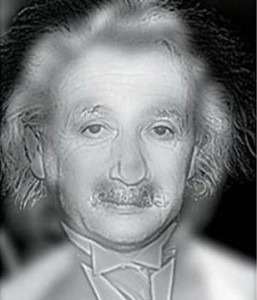Where I admit that this post is inspired by The Jesus Discovery / The Resurrection Tomb Mystery goings on, I feel that it is a point that is important to a much broader context: Mainly, that digital ink to outline what we think we see can be tricky business.
The image above has been all over the Internet so I’m not surprised if you’ve seen it before. In fact, I am not sure who had it first, so I am not sure who to give proper credit to (which makes my librarian sensibilities twinge…).
Now, if you are in the “seen it” camp, find someone who hasn’t and step them through the process and *watch* their reaction.
Step 1) Note that this image, assuming that you’re sitting in front of your computer monitor, looks like Albert Einstein. The sharpened details of his face are quite plain and unmistakable.
Step 2) Now, stand up and walk about 12′ away (the other side of the room) and then look back at the image.
…
Yes, so why does an image that looked so clearly like Albert Einstein suddenly become Marlyn Monroe?
The answer is a matter of detail. The sharpened details of Einstein’s face were superimposed upon a fuzzy image of Monroe. When looking at the fuzzy picture from a distance, the little sharpened details disappear leaving behind a broader image and your brain does the rest.
This is why “digital ink” techniques can be very tricky. If one does not enhance the correct elements of an inscription, one can literally superimpose onto the image whatever one wishes to see.
There was a similar problem with one of the first digital restoration attempts on the Dead Sea Scrolls. Weak lines sharpened can change letters around and alter entire readings, so with any reconstructive effort there is great responsibility to keep one’s enhancements as faithful to the underlying material as possible.
Peace,
-Steve


absolutely fascinating.
and it is a quite revealing testimony illustrating how the combination of a little unacknowledged digital ink can prime our cognitive capacities to see what we want to see if we are so predisposed.
Wow… I will never trust a digitally enhanced image again… ever… 🙂
I recently read a chapter by Bruce Zuckerman demonstrating similar principles for enhancing Scrolls readings. If you can create an entire human face from scratch, I’m sure a few letters would be child’s play!